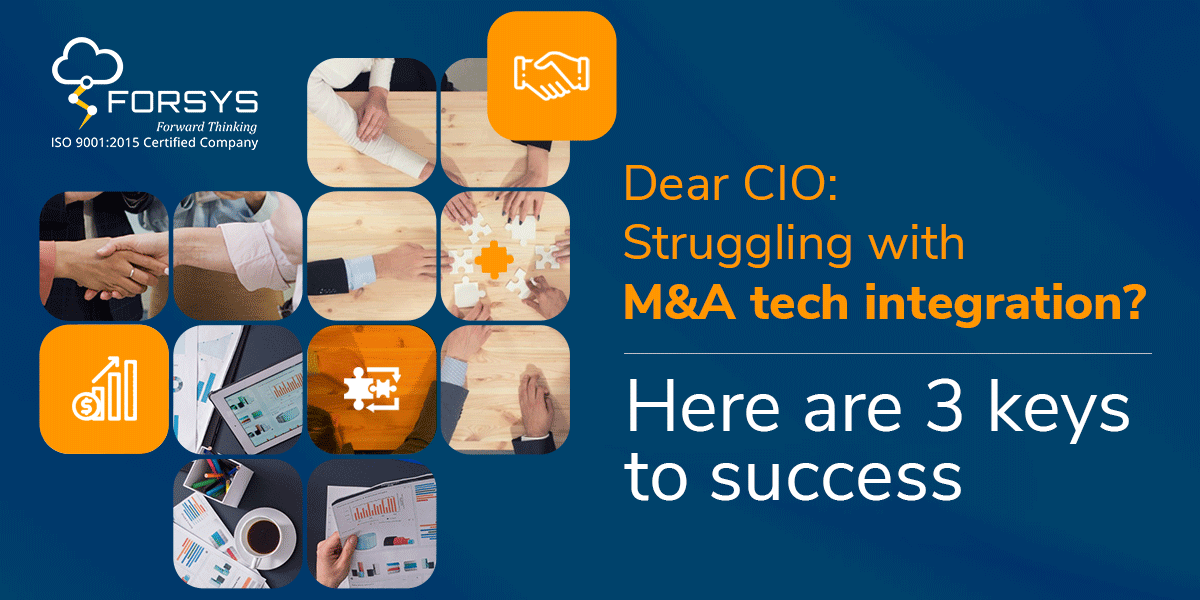Introduction
Today, it’s a whole new world for the chief information officers (CIOs). In the past, we saw CIOs primarily as the heads of corporate IT and back-office technologies. Things changed with the pandemic as the role of CIOs evolved greatly driving through technology mergers and acquisitions (M&As).
It has been observed that M&As are the quickest way for businesses to transform their business portfolio and bring improvement in their competitiveness through realizing synergies. However, reality tells a different story. In recent times, sizable M&As failed to bring expected value on time due to these top reasons:
- Lack of strategic clarity
- Overextending resources
- Lack of cultural fit
- Misevaluation of the integration complexities that include people and processes, and most importantly the systems & data
The focus of this article is to cover the top three key strategies to success with technology integration, which is often led by the CIO/team.
In PwC’s 23rd Global CEO Survey, nearly 80% displayed their concern about the speed of technological change. Does this mean that post-merger technology integration plays a key role in M&A? Yes, it does. The new-age businesses rely on technology support due to the level of automation and integration of business processes. Also, technology connects an enterprise’s all business activities, across the supply chain and internally. Irrespective of the sector or intention, almost all M&A transaction nowadays is connected by a common thread: dependency on technology to achieve the desired results.
CIO’s essential role in technology mergers
Their role in an M&A deal is paramount as they can enable businesses to create a smooth day-one experience. In the longer term, the expertise of CIOs comes in handy and is valuable for ensuring business continuity and for managing large-scale system and process modifications.
Technology’s critical position in the M&A activity enables the CIOs to be active and early participants in the M&A due diligence and integration planning processes. Since technology stands at the heart of M&A and drives successful integration, the CIO’s scope of work has widened to – evaluating the value and viability of potential technologies, planning and managing the integration of infrastructure and applications of the merged ventures.
As the cry for CIOs to get off the sidelines and get a seat at the M&A table is getting louder with every passing day, let’s take a closer look at how CIOs can realize the full potential of a technology merger.
Technology integration: Three keys to success
- Let go of the obsolete M&A approach and choose AI (and digital technologies) as it can enable easy and quick management of humongous amounts of data efficiently and comprehensively. According to Research, organizations that leverage AI for M&A can lower due diligence for specific tasks by approximately 30-90% when applied such as contract reviews.
- Before proceeding to merge, build a technology strategy that offers a roadmap for complete integration with the new IT platforms and a seamless end-to-end experience. Businesses must become digitally superior and migrate to the newer technology architecture to support quick integration.
Since it has been observed that integration issues have failed many M&A deals, CIOs can drive M&A success by leveraging advanced analytics and technology. Amongst the varied advantages include target screening, valuation, the discovery of potential loopholes if any, negotiation, and an improved playbook. The use of the cloud, analytics, virtualization, master data harmonization, and as-a-service technologies allows to raise the integration speeds and reduce costs.
- To enable successful integration of tools, platforms, and technology competencies with business partners, don’t take the lone road and go for collaborative efforts to get rid of risks and strengthen transformation timelines.
Technology mergers that have worked
Despite the world grappling with the after-effects of COVID-19, technology M&A activity in 2021 picked up a noteworthy pace. A report reveals that tech deal volume and value rose during the 2021 H1, with tech value witnessing 387% year-on-year growth and deal volumes growing 67% to 948 transactions. It’s not impossible for corporate combinations to work.
Some of the noteworthy deals of 2021 that grabbed headlines include AT&T and Verizon selling off their media assets, McAfee deciding to sell off its enterprise business to STG, Microsoft acquiring Ally.io, Veoneer’s buyout by Qualcomm, Intuit buying Mailchimp to name a few.
Parting remarks
There’s no denying that CIOs have a critical role to play in driving their organizations to transform their deal strategy and post-merger integration initiatives. With CIOs earning a seat at the deals table, they will continue to evolve and it displays no signs of slowing down. Going forward, businesses will lean on the CIOs as a strategy enabler for technology mergers.
Want to know how Forsys’ M&A integration expertise helped a fortune 500 navigate through M&A integration? Talk to us.

